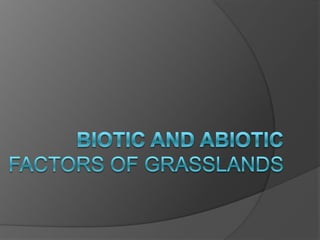
Eudece grasslands
- 2. Abiotic factors of Grasslands Each abiotic component influences the number and variety of plants that grow in an ecosystem, which in turn has an influence on the variety of animals that live there. The four major abiotic components are: climate, parent material and soil, topography, and natural disturbances.
- 3. 1) Climate includes the rainfall, temperature and wind patterns that occur in an area, and is the most important abiotic component of a grassland ecosystem. The climate in our grassland ecosystems is usually hot and dry in the spring and summer growing season, and cool or cold in winter dormant season.
- 4. Temperature, in tandem with Precipitation The amount and distribution of the rainfall an area receives in a year influences the types and productivity of grassland plants Temperature Grasslands occur in both high-temperature areas near the Equator and mid-to-low- temperature areas nearing subarctic regions. Grasslands that are near the Equator are generally either tropical grasslands or temperate. Grasslands that are further from the Equator are mostly temperate grasslands and montane grasslands.
- 6. Precipitation Tropical grasslands receive the most rain out of all the grassland biomes, up to 60 inches a year. Temperate grasslands receive much less annual rainfall on average (no more than 40 inches a year). Flooded grasslands, though they are very wet, also receive less annual rainfall than tropical grasslands, around 30 to 40 inches per year. Montane grasslands receive the lowest amount of precipitation, no more than 30 inches per year, and often, that precipitation is in the form of snow.
- 7. Humidity Tropical grasslands and flooded grasslands are very humid, meaning there is a very high percentage of moisture in the air. Temperate grasslands are somewhat humid, but can also be arid, meaning dry or little moisture in the air. Montane grasslands are typically very arid; however, some are mildly humid. During the hottest months of the year (the height of summer) more water evaporates from parts of the grasslands than falls as rain, creating a moisture deficit.
- 9. 2.) Parent Material and Soil Parent Material Much of the parent material underlying BC's grasslands was deposited as the last ice sheets melted away. In the Rocky Mountain Trench, for example, some material was deposited under a moving glacier, while on the Chilcotin plateau some was deposited under a stationary ice sheet; in many places throughout the grasslands material was carried and deposited by water on, in, or under the ice.
- 12. Soil The type of parent material in a particular area influences the texture of the soil, how well water flows through it, and hence the chemistry and nutrients of the soil. The fine silt soils found on the terraces of the Okanogan, Kootenay and Thompson valleys hold water near to the surface where it either evaporates or is soaked up by the dense fine roots of grasses; trees are not common in these areas. By contrast, in areas with gravel soils water moves quickly down to depths below the grass roots to levels where tree roots grow. As such, more trees are likely to be found in these areas.
- 13. glacial till (C) deposited by the ice as it melted 12,000 to 10,000 years ago. These soils have a deep organic-rich layer (A) that results from the breakdown of the roots and plant material each year. The organic layer increases in depth with increases in elevation and moisture.
- 14. 3.) Topography They generally occur in very hilly, uneven landscapes. Temperate grasslands are usually more flat and occur in areas of mid-to-low elevation. Flooded grasslands are almost all flat and in areas of low elevation. Montane grasslands are very mountainous and usually in areas of high elevation.
- 15. Aspect refers to the direction in which a piece of land is facing. slope is the angle at which the land lies. Slope is important in our grasslands as water may run downhill rather than soak into the ground where it is available for plants Elevation describes the height of land above sea level. Temperatures are generally cooler and rainfall is higher as elevation is gained.
- 16. 4.) Natural Disturbances change grasslands in many ways, adding to the diversity of these ecosystems. Some types of disturbance, such as annual flooding of riparian areas along rivers and streams, can be predicted while others, such as a fire after a lightning storm, happen unexpectedly.
- 17. Flooding The flooding waters can alter stream and river banks and move soil, broken trees and shrubs downstream. Lightning Storms Since grassland plants burn readily, fire spreads very quickly, and is thought to have been an important factor in maintaining the grasslands ecosystem. Fires are important for returning nutrients to the soil.
- 18. Biotic factors of Grasslands The biotic factors of the grassland ecosystem includes the autotrophs, and the heterotrophs, that is the producers, primary consumers, secondary consumers and the tertiary consumers. Primary producers: The primary producers include the autotrophs that can photosynthesize and includes the grasses, sedged, rushes, cyanobacteria. lichens, mosses, trees etc.
- 19. The primary and the secondary consumers includes the rabbits, moles , hares, elks, small dears in some places along with the phytophagous insects , snakes, preying birds, insect feeders and in some grassland ecosystems like in Africa where there are carnivores like the panthers. lions, foxes, wild dogs, etc The bacteria , fungi and other micro- organisms form the detritus food chain that is involved in the nutrient cycling of the grassland.
